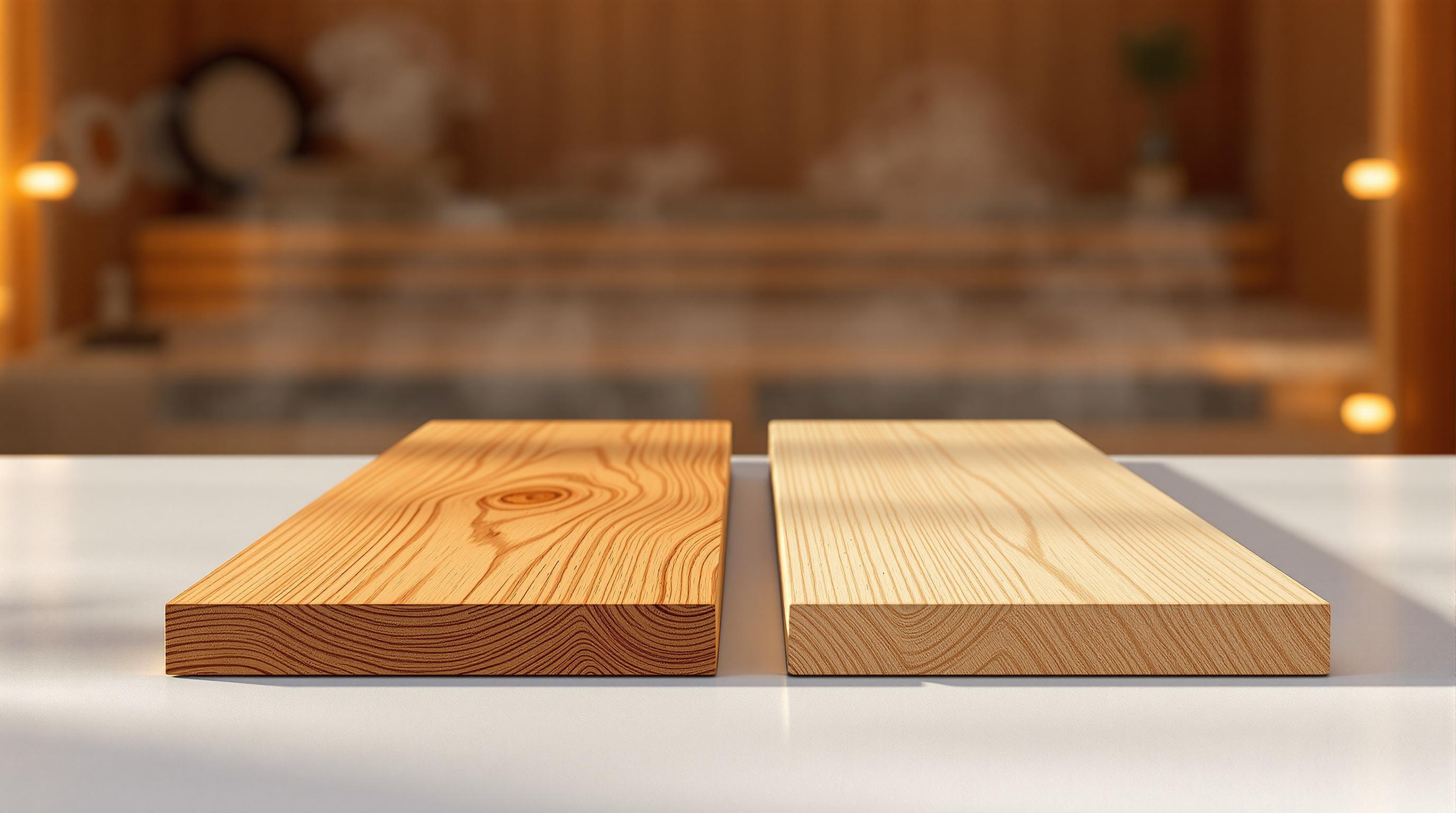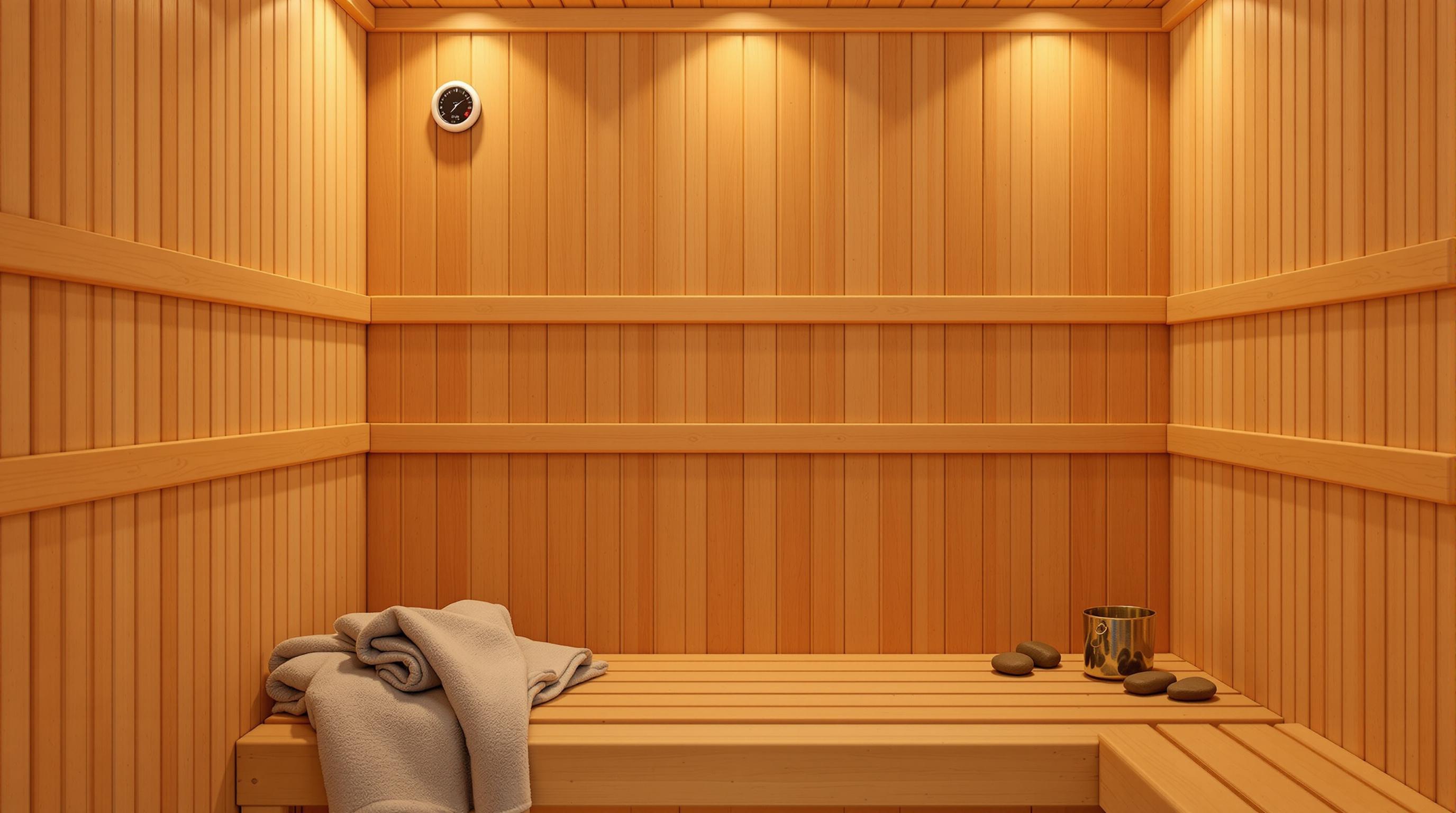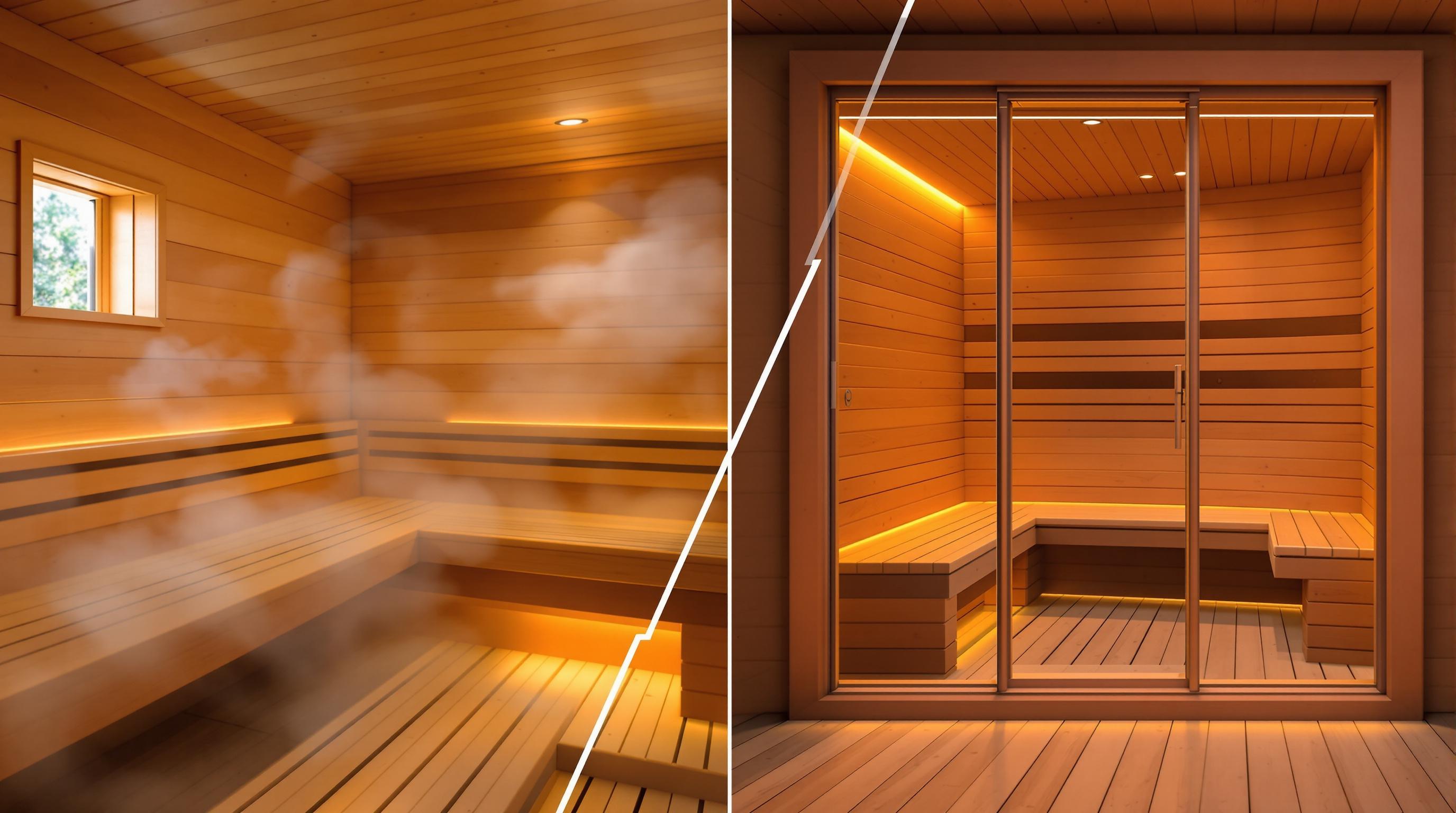Want your sauna to last longer and stay in top shape? Here's a quick guide to maintaining it properly. Regular care prevents mold, wood damage, and costly repairs. Follow these steps:
- Daily Care: Wipe down surfaces with a damp cloth, ensure proper ventilation, and let moisture escape.
- Prevent Mold: Keep humidity below 65% using a hygrometer, and clean surfaces with a vinegar-water mix.
- Protect Wood: Use food-grade mineral oil, beeswax, or sauna-safe sealants on benches, floors, and handles.
- Deep Cleaning: Sand wooden benches yearly, inspect heater stones, and clean heater components.
- Extra Tips: Use towels during sessions to protect wood and distilled water to prevent mineral buildup.
Key takeaway: Consistent cleaning, ventilation, and inspections can extend your sauna's life by reducing 90% of common maintenance issues. Keep it clean, dry, and ready for your next session!
Related video from YouTube
Daily Care Steps
Taking care of your sauna daily keeps it in good shape, extends its life, and ensures a clean, hygienic space. Follow these straightforward steps after each use to protect your sauna and keep it ready for your next session.
Wipe Down Surfaces
After your sauna session, grab a damp, soft cloth or brush and wipe down all surfaces. Focus on areas like benches, walls, and floors where sweat and bacteria tend to collect.
Here’s how to do it effectively:
- Use a damp microfiber cloth for cleaning, but avoid soaking surfaces with excess water.
- Start with high-contact spots like benches and backrests, and work your way down.
Let Moisture Escape
Once everything is wiped down, it’s time to tackle the moisture. Proper ventilation is key to preventing mold, odors, and wood damage.
To ensure good airflow:
- Open all vents and leave the door fully open for about 15 minutes. After that, keep it slightly ajar for another 15–30 minutes. If your sauna has fans, turn them on.
- During colder months or in humid areas, you might need to allow extra drying time.
- Check that all wooden surfaces are completely dry, especially in corners or tight spaces.
Sticking to these simple steps every day saves you from bigger maintenance headaches down the road. Plus, it keeps your sauna looking great, working well, and ready for a fresh, clean session every time.
Steps to Prevent Wear and Tear
To keep your sauna in great shape and avoid costly repairs, it's important to take steps to prevent common issues. Regular care not only keeps your sauna looking good but also extends its life.
Stop Mold and Odors
Humidity is a major culprit when it comes to mold and unpleasant smells in saunas. Use a small hygrometer to keep an eye on humidity levels - aim for below 65% when the sauna isn't in use. Excess moisture creates the perfect environment for mold and bacteria to thrive. To combat this, place moisture-absorbing products like DampRid or silica gel packets in corners during downtime.
Here’s how to keep mold at bay:
- Check dark corners weekly for signs of mildew. If the humidity in the room goes over 60%, consider using a dehumidifier.
- Clean surfaces with a mix of white vinegar and water (1 part vinegar to 4 parts water) for a natural and effective solution.
While controlling humidity helps, you’ll also need to take care of the wood to ensure it stays in good condition.
Protect Wooden Parts
Using the right products and techniques can preserve the natural beauty and durability of your sauna's wooden components. Avoid regular household cleaners, as they can harm the wood.
Here’s a quick guide for caring for sauna wood:
| Area | Care Method | How Often |
|---|---|---|
| Benches | Apply food-grade mineral oil | Every 4-6 months |
| Door handles | Use a natural beeswax sealant | Every 3 months |
| Floor boards | Treat with sauna-grade sealer | Annually |
| Wall panels | Light sanding + cedar oil | Yearly |
For areas that get touched frequently, like door handles and bench edges, a thin layer of sauna-safe wood sealant will provide extra protection.
sbb-itb-3953eb0
Deep Cleaning and Yearly Checkups
Regular yearly maintenance is key to keeping your sauna in great shape and avoiding expensive repairs. A deep cleaning routine, paired with annual inspections, ensures your sauna runs smoothly and lasts longer.
Sand Wooden Benches
Once a year, refresh your wooden benches with light sanding. Use fine-grit sandpaper (180-220 grit) to gently smooth out worn or rough areas, following the wood grain to maintain its quality.
After sanding, shift focus to the heating elements to ensure everything continues to work efficiently.
| Area | Tool | Technique | Frequency |
|---|---|---|---|
| Seating surface | 180-220 grit sandpaper | Light circular motions | Annually |
| Bench edges | Fine-grit sanding block | Follow the wood grain | Annually |
| Support beams | Soft brush | Regular cleaning | Quarterly |
Clean Heater and Stones
Pay close attention to your sauna’s heating system during deep cleaning to keep it running effectively and avoid damage. Start by disconnecting the power for safety. Carefully remove the stones and inspect them for cracks or wear. Use a soft brush to clear debris from both the stones and the heater housing.
Steps for heater care:
- Rinse stones with water to remove dirt.
- Vacuum out any loose debris from the heater housing.
- Wipe interior surfaces with a lightly damp microfiber cloth.
- Let all components dry completely before putting them back together.
Once the heater is clean, focus on refreshing the sauna's appearance by addressing any stains or scratches.
Fix Stains and Scratches
Take care of stains and scratches promptly to prevent lasting damage. For tough stains, use a damp sponge with mild soap made for sauna wood. To handle discoloration caused by sweat or moisture, apply a specially designed sauna wood cleaner and gently buff the area. For scratches, apply a thin coat of sauna-safe wood sealant. Let it dry completely (about 24 hours) before using the sauna again.
Extra Tips for Better Maintenance
In addition to routine cleaning and inspections, a few simple practices can help keep your sauna in great condition with less effort.
Use Towels During Sessions
Placing towels on benches and floors during sauna sessions helps protect the wood from sweat, reducing the need for deep cleaning. Opt for materials like cotton or bamboo - cotton absorbs well, bamboo has natural antimicrobial properties, and microfiber dries quickly.
After each use, wash the towels at high temperatures to remove bacteria. Store them in a dry, well-ventilated space to keep them fresh and ready for the next session.
Use Distilled Water
Distilled water is a smart choice for steam generation, as it prevents the mineral buildup that can damage sauna components. This is especially important for steam and infrared saunas, where water quality directly affects performance and longevity.
Here’s how to get the most out of distilled water:
- Empty and clean water containers weekly: Refill them with fresh distilled water to minimize residue.
- Inspect steam outlets monthly: Check for any signs of mineral deposits and clean as needed.
- Flush water lines quarterly: This prevents buildup and ensures smooth operation.
"Using distilled water in saunas significantly extends the lifespan of sauna components by preventing mineral deposits and damage. This reduces the need for frequent repairs and replacements, making sauna maintenance more efficient and cost-effective."
Sauna Maintenance: Key Takeaways
Taking care of your sauna isn’t just about keeping it clean - it’s about ensuring it lasts longer and performs better. Regular upkeep is an investment in safety, health, and durability.
Proper ventilation and moisture control play a huge role in sauna care.
"Adequate airflow and moisture management can prevent up to 90% of common sauna maintenance issues", says Finnish sauna expert Matti Kiukas.
Deep cleaning and annual inspections are also critical. They help catch wear and tear early, keeping your sauna running smoothly.
"Well-maintained saunas have 75% fewer incidents of mold-related issues and require significantly fewer repairs", explains Dr. Sarah Chen from the Nordic Sauna Institute.
Preventive care doesn’t just save headaches - it saves money. Research from the International Sauna Association shows that regular maintenance can cut annual repair costs by up to 60%, while ensuring your sauna stays in peak condition.
Keep these tips handy, and your sauna will reward you with years of reliable performance.
FAQs
Do infrared saunas need maintenance?
Infrared saunas are naturally resistant to bacteria and mold thanks to their dry heat. However, regular upkeep is still necessary to extend their lifespan. The International Sauna Association notes that proper maintenance can help them last up to 40% longer. To clean, avoid soaking surfaces and stick to soft microfiber cloths designed for infrared saunas.
Even though infrared saunas have lower moisture concerns, using the right cleaning products is crucial for all sauna types.
What cleaner to use in a sauna?
Here are some expert-recommended cleaners for different sauna surfaces:
| Surface Type | Recommended Cleaner | Notes |
|---|---|---|
| Wooden Benches | Mild dish soap + warm water | Do not clean while the sauna is in use |
| Floor Areas | Chemical-free mild detergent | Pay extra attention to high-traffic spots |
| Glass/Metal Parts | Vinegar solution (1:3 ratio) | Avoid letting it drip onto wooden areas |
"Using harsh chemicals can cut the lifespan of sauna wood by up to 50% and may release harmful fumes when heated", says Matti Kiukas, a sauna maintenance expert.
For tougher stains, try a natural scrub made from baking soda and water. It's gentle on wood and highly effective.


